
Background information
When upside down is the right way up – Tetropots store electric toothbrushes
by Pia Seidel

Samer Selbak’s a designer. He creates objects from a long forgotten natural product – luffa. In this interview, he recalls how he had always admired the plant in his grandparents’ garden.
Samer Selbak, who grew up in Shefar'am, east of Haifa, in Israel’s northern district, had long been preoccupied with his roots. But it wasn’t until he moved to Paris to study product design that he started digging deeper. Since he lived so far from home, he wanted to immerse himself further in the different traditions of his culture and appreciate its beauty. An object that once existed in every Palestinian household came to his mind: the luffa sponge. It’s made from the dried pulp of the luffa fruit and is suitable for cleaning as well as for personal hygiene.
Today, the luffa sponge has been largely displaced by sponges from industrial production. To find out why people stopped using the natural sponge, the 31-year-old started the Luffa Project. He decided to explore the advantages of natural fibre and use them in his designs because he only wanted to use materials that wouldn’t create waste or problems for the environment.
What made you study product design?
Samer Selbak: I grew up with many different art forms: painting, drawing, photography, dancing and making music. So I wanted to do something where I feel the same diversity in my work and where things are constantly changing. As a designer, I can constantly talk about topics that come to my attention – without being tied to just one medium.
You graduated from the ENSAD art school in Paris more than a year ago. What happened next?
For me, it was really important to try and be heard from the very beginning. I felt like my own ideas would get lost if I worked for another design studio. So I immediately decided to go self-employed.
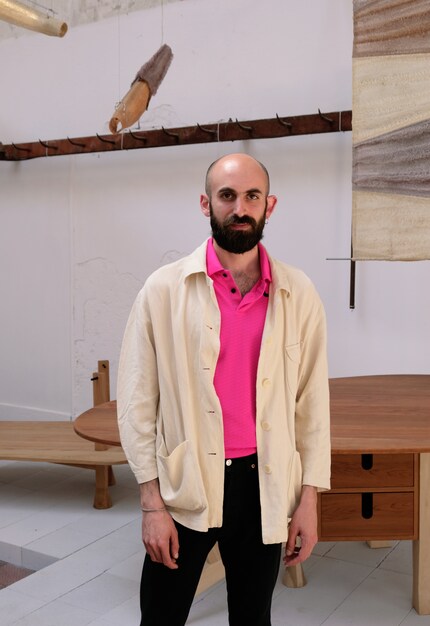
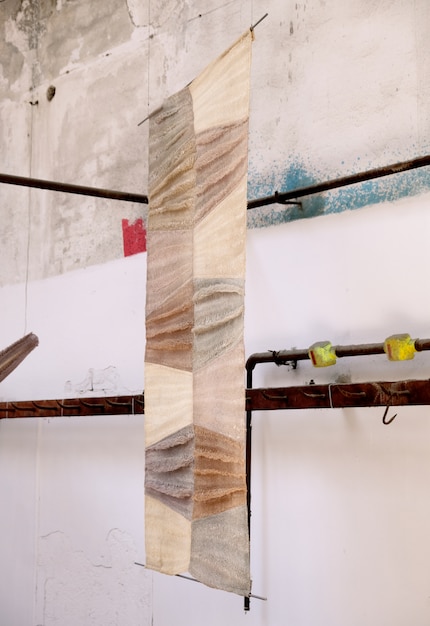
You’d already started the Luffa Project during your studies. What’s it all about?
I’ve been familiar with the luffa plant since I was a child. I remember so well how it grew in my grandparents’ garden. It’s fruits looked like something from a different planet. They looked huge to me. Not just because I was so small. Even today they’re larger than the fruits of most other trees. When they dry, they’re bell-shaped, hollow inside and made of numerous interwoven fibres.
Did you want to work with luffa as an adult because of the special attraction you had to the plant as a child?
Yes, the plant fascinates me. I wanted to find a way to reinterpret both the plant and its natural fibres. At first, however, I had a hard time getting the bath sponge out of my head and imagining new uses or shapes.
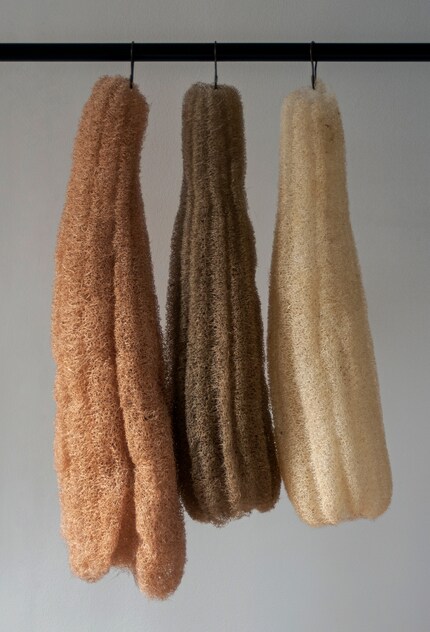
How did you manage to shake that sponge image in the end?
I stopped seeing the plant from the perspective of a child who had grown up. Instead, I looked at the natural material as a designer and explored it like a scientist. I realised that I could use design as a tool to make something new out of luffa without neglecting its natural properties. When I thought of dying it, an old tradition of my Christo-Palestinian community came to mind – colouring Easter eggs. We often used onion skins or native flowers. I applied this process to luffa to see it in a new light.
I realised that I could use design as a tool to make something new out of luffa.
What did you do with the dyed material?
Besides the colour, I also wanted to emphasise the special texture. That’s why I came up with the idea of designing a lamp and a room divider. You can play with transparency, colour, light and shadow with both.
You’ve chosen to combine a natural material with steel. How does steel feel compared to luffa?
What I like about metal is that it shines, it’s robust and lasts a long time. It gives the necessary heaviness and a new aesthetic, attitude and weight to the luffa objects, emphasising the soft and earthy texture.
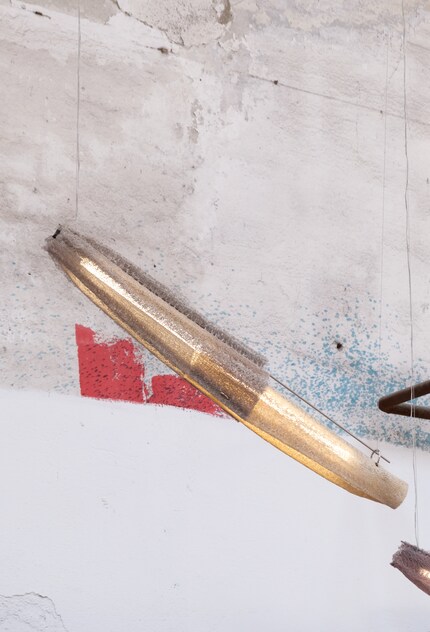
Where do you get luffa today, from your grandparents’ garden still?
Unfortunately not. The first luffa plant I used in my designs came from a local store in my hometown. The owner was very surprised and wanted to know why I needed it. She had also noticed that the sponge had disappeared from the scene and was only bought by the old generation.
Why is that?
I believe that many people felt oppressed in my culture and, in response, turned their attention to the West. They preferred to reach for plastic sponges instead of the old-fashioned luffa sponge, which originated in the East. Today, however, change is happening. I observe that my generation in Palestine is no longer ashamed of old traditions. And even the West is now looking to the East to learn more about our history and find inspiration.
Are there other cultures who use the luffa plants?
Yes, it’s very popular in Egypt and was discovered there – at least its full name «Luffa aegyptiaca» refers to it. The plant is used for sponges in Asia too. However, it’s more common to eat its fruits while they’re still young. In China, for example, they’re eaten with noodle soup. They taste similar to pumpkin or cucumber.
Could you grow luffa in Paris?
In principle, yes. However, I think the plant would thrive better in the south of France. There used to be a farmer who grew luffa near Bordeaux. I don’t know why he stopped, though. Perhaps because the plant is so unknown in this country. However, if you want to try it in Zurich, all you need is enough water and at least six months of sun and warmth. It doesn’t have to be 38 degrees like in Palestine.
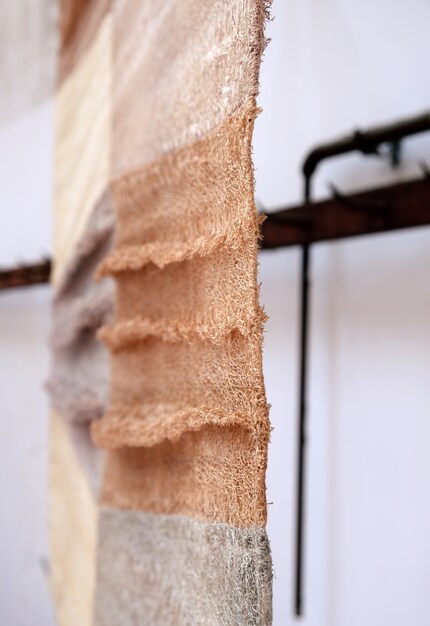
What are the properties of the dried fruit?
It can absorb a lot of water and is therefore perfect as a sponge. When it gets wet, the fibres go soft. In its dry state, on the other hand, the fibres are stiff, coarse and light. However, the most magical thing about it is that it can retain shape. If you squeeze the sheath when dry and apply heat at the same time, it will become compact and stay that way. Unless you get it wet. Then it’ll go back into its original form.
Does luffa as a material also have weaknesses?
When it’s dry, the fibres can tear. So it’s not really suitable for making fabrics or covers for furniture. This is exactly the beauty of the natural character of luffa. Industrial materials like plastic are versatile and can be used for almost anything. But I find it boring to use one material for all kinds of objects. Luffa teaches me to accept boundaries and celebrate opportunities. I’ve never established such a close relationship with a material.
Luffa teaches me to accept boundaries and celebrate opportunities.
When you compare luffa to other natural materials, which would it resemble?
It shares many properties with hemp, cotton or rattan, but it’s grown in a very different way. For example, luffa requires much less water, care and space to grow than cotton because it’s a vine plant which climbs upwards. This makes it easier to cultivate in the smallest of spaces.
What would be the ecological impact of a possible luffa hype?
It depends on where it’s grown. In Egypt, it’s usually grown on riverbanks so that it doesn’t need to be artificially irrigated. After the vines have dried out, the sheaths are collected by hand. Then you put them in the river so that they’re soft and the top layer of skin is easier to peel off. So it’s always processed with the available local water and by hand too. All it requires is physical work. If we can maintain this process and not turn it into an industrial material, it’s very environmentally friendly.
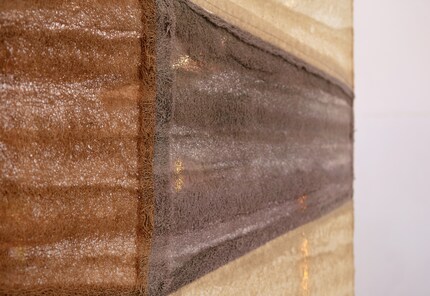
What’s next for the Luffa Project?
I’ll continue to make the lamp as well as the screen for private clients and galleries who are interested, but I’m just discovering a new part of the project, which I call «Luffa Ceramics». For this I’m mixing luffa with clay instead of steel. The result has a fossil-like appearance, as the texture of luffa is still visible. It almost feels like I’m immortalising the once soft material while breathing new life into it.
What kind of people are always on the lookout for better design solutions? The people dreaming up new chair or table designs even though there are thousands of them out there already? In this series, I’ll introduce you to these inspiring people and their leitmotifs. Don’t miss out on the next article by clicking on the Follow button.
Header image: Pia SeidelLike a cheerleader, I love celebrating good design and bringing you closer to everything furniture- and interior design- related. I regularly curate simple yet sophisticated interior ideas, report on trends and interview creative minds about their work.